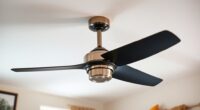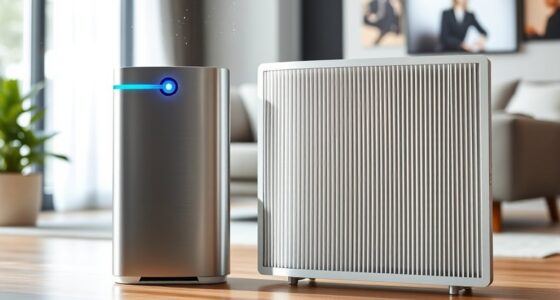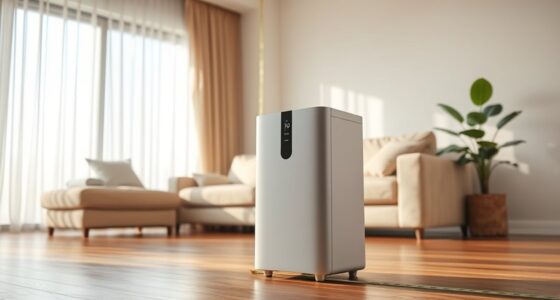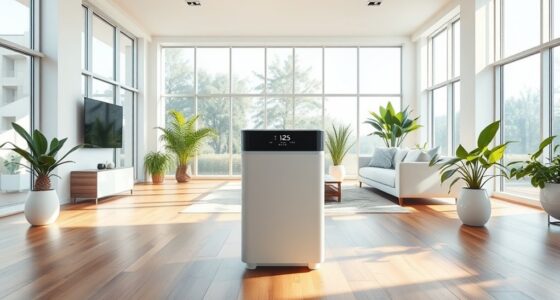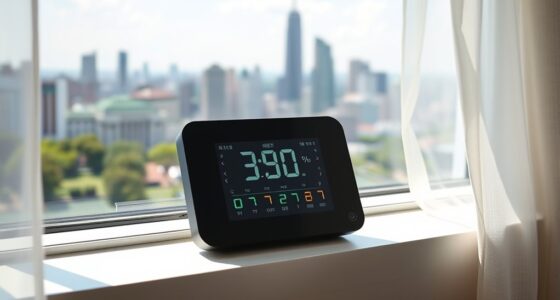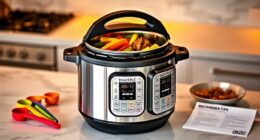You should replace your air purifier filters every 6 to 12 months to keep your device working effectively and improve air quality. The exact timing depends on factors like pollution levels, pets, and indoor activities such as smoking. Regularly check for visible dirt, dust, or alert indicators to avoid clogged filters. Staying on top of replacements guarantees better airflow and healthier air—if you want to learn more about proper maintenance, keep going.
Key Takeaways
- Replace HEPA filters every 6 to 12 months for optimal air purification.
- Increase replacement frequency in high pollution, pet, or smoking environments.
- Check device indicators or look for visible dirt and discoloration regularly.
- Clean pre-filters and maintain the device to extend filter lifespan.
- Regular filter changes ensure better air quality and prolong your air purifier’s lifespan.
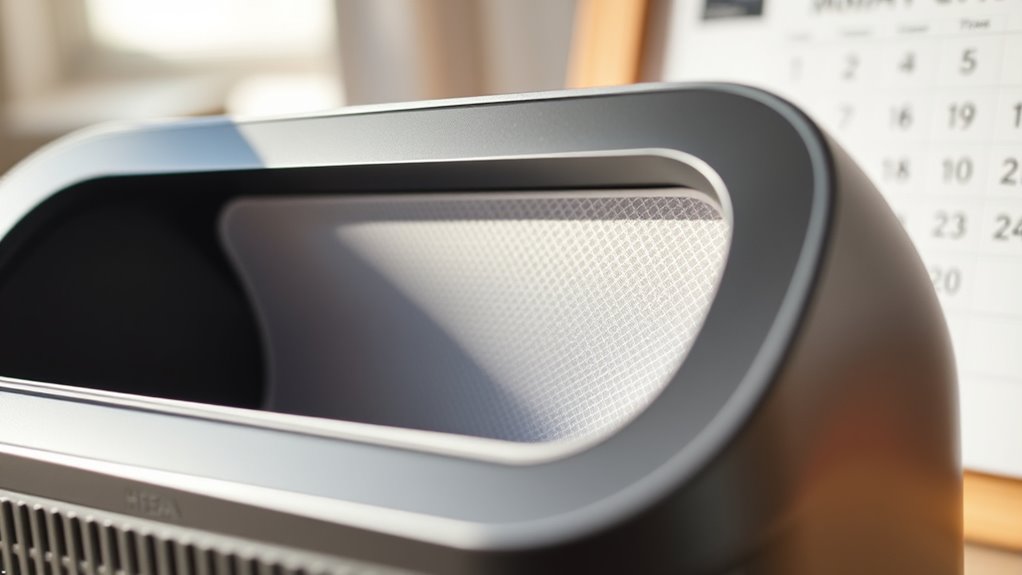
Replacing your air purifier filters is a simple but essential task to guarantee your device continues to clean the air effectively. Proper filter maintenance directly impacts your air quality, ensuring harmful particles, allergens, and pollutants are removed efficiently. Neglecting to replace filters as needed can cause your air purifier to work harder, reducing its lifespan and diminishing its ability to improve the air in your home or office.
Generally, how often you should replace your filters depends on several factors, including the type of filter, the usage intensity, and the air quality in your environment. For most HEPA filters, manufacturers recommend replacing them every 6 to 12 months. However, if you live in an area with high pollution levels, or if you have pets, smoking indoors, or allergies, you might need to change filters more frequently. These triggers tend to clog the filter faster, which can compromise air quality and strain your device.
It’s important to monitor your air purifier’s indicators if it has a filter change alert system. Many models come with built-in sensors that notify you when it’s time to replace the filter. If your device doesn’t have this feature, make a habit of inspecting the filter monthly. Look for visible signs of dirt, dust, or discoloration. When the filter appears clogged or dirty, it’s time to swap it out. Remember, a clogged filter restricts airflow, reduces efficiency, and can even cause the device to overheat.
Regular filter maintenance isn’t just about replacing filters on schedule; it also involves cleaning the pre-filter, if your unit has one. Pre-filters catch larger particles and can often be washed or vacuumed, extending the life of your main filter. Keeping your device clean and well-maintained ensures that it continues to perform at its best, which directly benefits your air quality. Better air quality means fewer respiratory issues, allergies, and a healthier living environment overall. Additionally, choosing a filter with high Clean Air Delivery Rate (CADR) can maximize your purifier’s effectiveness in removing airborne contaminants.
Frequently Asked Questions
Can I Wash and Reuse My Air Purifier Filters?
You might wonder if you can wash and reuse your air purifier filters. While some filters, like foam or washable types, can be cleaned through filter cleaning and reused, most HEPA filters aren’t designed for washing and may lose their filter lifespan if you do. Always check the manufacturer’s guidelines. Proper filter cleaning can extend your filter’s lifespan, but replacing filters when needed guarantees your air stays clean and healthy.
Do Different Filter Types Require Different Replacement Schedules?
Sure, because who wouldn’t want a one-size-fits-all answer for filter lifespan? In reality, different filter types demand varying replacement frequencies; HEPA filters might last a year, while carbon filters could need change every 3-6 months. Your air purifier’s manual offers the best guidance. Ignoring these schedules risks reduced efficiency and poor air quality, so stay vigilant and replace accordingly to keep your home fresh and healthy.
How Do I Know if My Filter Needs Replacing Sooner?
You can tell if your filter needs replacing sooner by observing its filter lifespan and replacement indicators. When filters become visibly dirty, clogged, or start to emit bad odors, it’s a sign they’re nearing the end of their lifespan. Additionally, if your air purifier’s performance drops or the filter indicator light activates, it’s time to replace the filter. Regular checks help guarantee ideal air quality and device efficiency.
Do Air Purifiers With HEPA Filters Last Longer?
Ever wonder if HEPA filters truly last longer? The answer hinges on filter lifespan and durability. While HEPA filters are designed for efficiency and typically have a longer lifespan, their durability depends on usage and maintenance. You might think they last forever, but neglecting regular checks can reduce their effectiveness. To maximize their lifespan, follow manufacturer guidelines. Stay vigilant—your air quality depends on it.
Are There Signs My Air Purifier Is No Longer Effective?
You might notice your air purifier isn’t working as well as before, which are clear effectiveness indicators. If you see reduced airflow, persistent odors, or increased dust, your filter’s lifespan could be nearing its end. Regularly check the filter for dirt buildup and replace it when it’s visibly dirty or after the recommended time. Staying attentive to these signs ensures your purifier maintains peak performance and air quality.
Conclusion
Remember, your air purifier’s filters are the unsung heroes in your home’s clean air battle. Replace them on the recommended schedule to keep your environment fresh and healthy. Think of your filters as the gatekeepers—once they’re overwhelmed, toxins slip through. Don’t let neglect turn your guardian into a silent threat. Stay vigilant, replace when due, and breathe easy—because clean air isn’t just a goal, it’s a promise you make to yourself every day.

